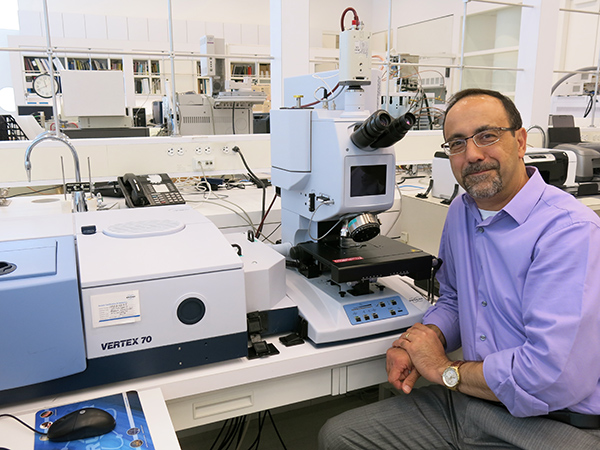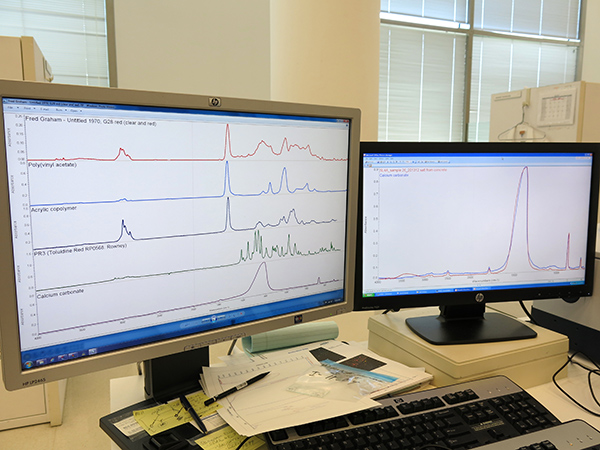
Herant Khanjian in a Getty Conservation Institute lab with an FTIR machine
Staff members of the Getty Conservation Institute (GCI) come from a great variety of disciplines. Chemists, architects, biologists, engineers, and other specialists lend their expertise to advance conservation of the world’s cultural heritage. Just as diverse as the staff’s backgrounds are the types of tools they use to aid the GCI’s conservation efforts.
Previously on the Conservation Tools Series, we looked at how conservation scientists use the USB Microscope and the Universal Testing Machine (UTM) to test materials in the field and in the lab, respectively, and how they employ Gas Chromatography/Mass Spectrometry (GC/MS) to identify different organic compounds in samples taken from works of art,
Now let’s look at a technique related to GC/MS, Fourier-Transform Infrared Spectroscopy (FTIR).
What Does the Tool Do?
Herant Khanjian, an assistant scientist at the Conservation Institute with a background in chemistry, uses FTIR to characterize natural and synthetic materials in works of art.
Like GC/MS, FTIR requires samples of only miniscule size—weighing just several micrograms—taken from an inconspicuous location in works of art. The sample is put on an infrared window and analyzed under infrared light. In a matter of seconds, the FTIR instrument produces a graph called a spectrum. The peaks in the spectrum represent chemical bonds between two atoms or groups of atoms in a molecule.
Since each material has a unique combination of atoms, no two compounds produce identical spectra. “A spectrum is like a fingerprint of the chemical that you are examining,” Herant told me. “Each one has a unique profile, and so you can distinguish between different chemicals using their spectra.” Herant identifies materials by matching the sample’s spectrum to reference spectra of known materials.
Herant has worked to identify so many different materials from artworks that he can “look at a spectrum and recognize, for example, a protein or a wax, just by visual identification of these graphs.”

Examples of spectra obtained via FTIR
How Does It Advance Conservation Practice?
Using FTIR, Herant has characterized materials in modern paints as part of the Conservation Institute’s Modern and Contemporary Art Research Initiative. Knowing exactly what components make up the artwork allows conservators to decide the best treatment procedures and materials to use for conservation. Moreover, the chemical information “also gives art historians and curators a better understanding of how artist’s materials were used over the decades,” Herant says.
However, unlike GC/MS, which requires the sample to be broken down by heat or chemicals in order to be analyzed, FTIR is a nondestructive technique. The sample can be recovered to carry our further analyses.
Herant has also performed a chemical mapping of a tiny cross-section of a wooden piece of furniture that was painted with several layers of paint over the years. Using FTIR, he can examine each layer of paint separately and map out the composition in the cross-section.
Herant is currently involved in the study of teak wood fenestrations at the Salk Institute for Biological Studies, completed in 1965, in La Jolla, California. Chemical mapping techniques were conducted on samples to determine the presence of a black fungal layer and various other deposits, including adhesives, coatings, and minerals on the surface of the wood.

The Conservation Institute’s FTIR lab setup.
Conservation Tools is an occasional series featuring tools essential to the work of the various specialists at the Getty Conservation Institute.




Comments on this post are now closed.